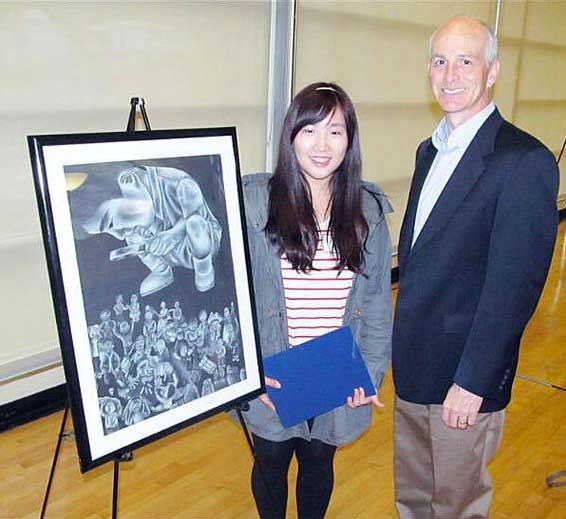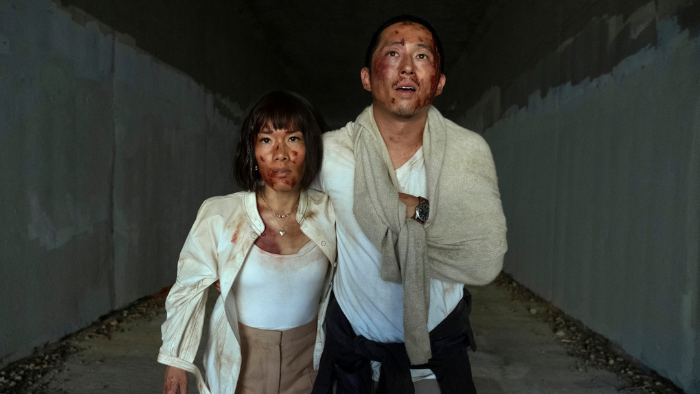Laundry by Shelli Segal has long been the go-to label for easy cocktail dresses for their stylish and unique designs, while still staying affordable. In their latest national design competition to “Design the Perfect Little Black Dress,” Korean American interior designer Sarah Ahn took home first place with her winning design. The “Sarah” dress, named after the winner, is a knee-length, slip-on design with a V-neck in both front and back and cap sleeves. It’s available now through October at Nordstrom, Dillards, Macy’s, Zappos, Polyvore, 6pm.com and shopstyle.com.
What’s surprising is that Sarah initially worked in the neuroscience field. Her experience shows that people don’t always grow up knowing what they want to do, nor do they enter school or the work force pursuing their interests. People may spend years working on something they aren’t truly passionate about only to discover later that it wasn’t something they wanted to do for the rest of their lives. Unfortunately, it took a tragic event, her brother’s motorcycle accident, before she had the courage to go into the arts, something she had always loved growing up. Here, we talk to Sarah about her inspirational story, her winning LBD, and her thoughts on eco-fashion.
BACKGROUND
Where you were born: Daegu, South Korea
Where you were raised: Everywhere. My dad served in the U.S. Army for 24 years in the medical brigade, so I’ve moved 22 times before the age of 18. The longest I’ve lived anywhere was in the small farm town of Sun Prairie, Wisc.
Age: 32
Education: BS in Physiological Science, MS in Physiological Science, PhD in Molecular, Cellular & Integrative Physiology – all from UCLA

ABOUT YOUR DESIGN CAREER
Growing up, have you always been involved in the arts? Were your parents supportive of it?
All throughout my childhood, I’ve won awards in art. I’ve had a lot of support and encouragement from my art teachers and my parents as well. They never forced me to become a doctor or a lawyer, as many Asian parent stereotypes suggest.
It seems you are not only talented, but interested in the arts, so why did you initially enter college studying physiological science?
One day, I submitted an art piece that didn’t follow the teacher’s instructions for the art piece. I chose to add something else to the piece that I felt was more conversational and thought-provoking. While she said she would give me an “A” for the quality of the artwork, she gave me an “F” strictly based on not following the assignment. She explained at the time that she wanted me to understand that an artist in the real world must follow the instructions of their clients or they would not be paid for their work. The idea that I would have to make art for others was suffocating. I always drew for me … it was my escape, my savior from the loneliness that follows an Army brat that has to make new friends from place to place, my outlet to express things I could not do in words. So overnight, I chose my next favorite topic: biology. I became a certified nurse assistant at the age of 17. I also entered an essay contest about the future of medicine in the 21st century and won the grand prize in the state of Texas.
Even after you received your PhD, you decided to change your mind and pursue a career in design. Why is that?
After being a postdoctoral fellow at Northwestern University for only three months, I got a phone call from my parents on January 7, 2007. My brother had gotten into a motorcycle accident. He was in a coma for two months then onto rehab. He had endured severe brain injury. With the efforts of my parents, we were able to get him to eat and talk again, to raise his arms and finally, to walk again. When he was well enough to go home to my parents, I went back to my position at Northwestern. I was alone in my lab space performing neurosurgery on mice to study the spinal cord with respect to walking. At the end of the day, I could no longer euthanize the animals as I did before my brother’s accident. When I was back home and away from the lab is when I couldn’t go back to doing what I did before. It was at this juncture where I made the pivotal decision to pursue another career. And after all these years, I am back to art.
I believe things, initially apparently good or bad, always happen for a good reason. My brother is doing well now … well on his way to recovery. If it weren’t for this crisis in my life, I would not have had the push or courage to make the change. As a result, even though the future isn’t always clear, I know that I am very happy with my decision.
Was it difficult making the change?
Yes and no. No because I had the moral and financial support of my husband, who encouraged me to look deeper into my passion of the arts. On the same token, my change led me to move away from my husband to L.A. so that I may attend FIDM. We’ve had a long distance marriage for over one and a half years now. The iPhone FaceTime feature has helped keep our marriage sane!
Yes because despite my parents initial support of my artwork in high school, now after having a PhD, they found my new career path to be below me. I suspect my mom thought that I had deserted my PhD to become a sweat shop seamstress. That is something I hear from friends and strangers as well … “Do you feel like your PhD was a waste? You’ve thrown it away! And all that time it took for you to get it.” Well, I haven’t thrown it away. I will always have it. It only took me four years to get it and everything I’ve learned from the experience. It’s been hard to even share this dress contest win with my parents. They just don’t get the magnitude of it.
How did you start off your design career and where do you plan on going with it?
I started with the fact that I owned 2,000 lbs of clothes. I know this for a fact because when my husband and I moved from L.A. to Chicago, we had a 5,000 lbs limit. The movers weighed my closet and discovered that I literally own a ton of clothes. Ha!
I give credit to my schooling at FIDM. I took full advantage of all the opportunities it offered. I thank my fashion illustration teacher for empowering me with the skill to be able to put the ideas in my head onto paper in a way that others can now understand what I’d like to make as well.
I have met with my manufacturers overseas to produce both my fashion collection (debuting this fall) and my home furnishings line (throw pillows, bedding, drapes, etc., also launching this fall). I would like to expand from residential interior design into hospitality (hotels). I just want to make beautifully colorful, geometric, bold, and cleanly designed fashion and home accessories so we can be surrounded in beautiful things that please the eye and uplift our spirits.
ABOUT THE CONTEST
How did you find out about the Laundry by Shelli Segal LBD design contest and why did you decide to enter?
As a student at FIDM, I would frequently check their career website for any scholarship or contests to apply for. I’ve never heard of the contest before and I happened to have some spare time and decided to turn in a sketch. It seemed easy enough to sketch something, scan it and email it in with my design concept.
How did you feel the moment you found out you won?
My husband and I had just arrived at our hotel. I was checking my email. I thought initially it was spam mail. When I read closer, I started to cry. I felt like the win justified and validated my career change. It somehow reassured me that the risk I took in being apart from my husband, giving up my income, taking out a large loan, being at odds with my parents was just a tiny bit … worth it. It was unbelievable.
What was the concept behind your design?
Designing a “perfect” little black dress was daunting. There are so many possible options. After brainstorming several rough sketches, I finally decided on one that can be versatile, a go-to classic dress for any occasion that can be dressed up or down. So then I decided to make it reversible to make two different looks in one. In my initial design, I included a boat neck for a more modest look and a deep v-neck for a night look. I also added unattached side seam pockets because women always love dresses with pockets, especially non-bulky pockets. I wanted the dress made from a stretchy jersey to fall just above the knee at its full length to provide an elongating illusion which is slimming for any woman but that can be hiked up a bit to be shorter for a night out on the town if she wished.
ABOUT ECO-FASHION
I know you support living a green life; has that influenced your designs in some way?
I learned very early that my birthday was connected to the international celebration of Earth Day. In interior design, I make efforts whenever possible to reuse items that clients already have in new ways by repainting them or refurbishing them in some way to keep them out of landfills. In fashion design, I’d like to make clothing that would work in combination with many other items that already exist in a woman’s closet so that she doesn’t need to buy clothes so often and thus adding to landfills when it is discarded. I also like to buy clothing from thrift stores to add to my wardrobe or to deconstruct and reconstruct into something new thus recycling the fabric. I also plan on working with sustainable materials such as bamboo for both interiors and fashion. New techniques make bamboo now a very soft fabric to work into apparel.
What can people do to be more involved with, and promote eco-fashion?
Women can support designers that use sustainable fabrics and apparel that are designed around achieving more than one look (reversible, inside out, etc) to reduce fabric waste in landfills. Women can also try shopping more often from thrift stores. Or hold clothing swap parties. Get a bunch of girlfriends that are roughly the same size as you are and ask everyone to bring their unwanted clothing. Then let the trading begin! Your trash can be someone else’s treasure.





